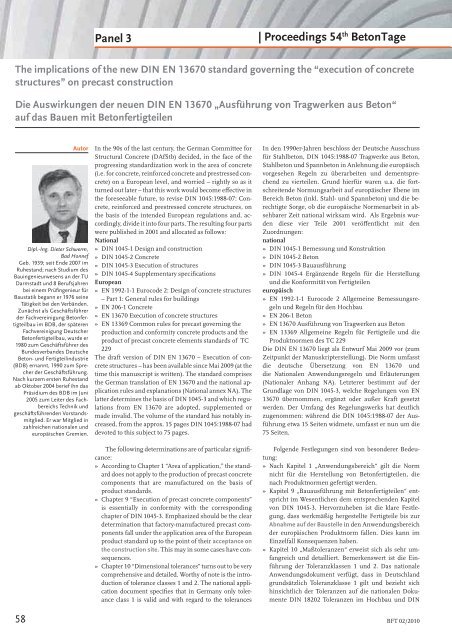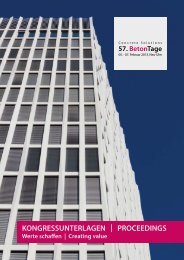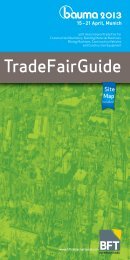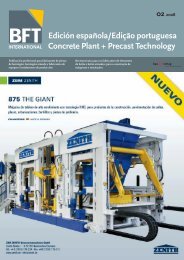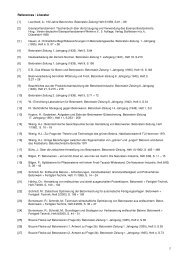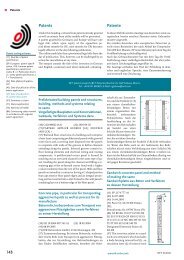Concrete Plant + Precast Technology Betonwerk ... - BFT International
Concrete Plant + Precast Technology Betonwerk ... - BFT International
Concrete Plant + Precast Technology Betonwerk ... - BFT International
Sie wollen auch ein ePaper? Erhöhen Sie die Reichweite Ihrer Titel.
YUMPU macht aus Druck-PDFs automatisch weboptimierte ePaper, die Google liebt.
58<br />
Panel 3<br />
| Proceedings 54 th BetonTage<br />
The implications of the new DIN EN 13670 standard governing the “execution of concrete<br />
structures” on precast construction<br />
Die Auswirkungen der neuen DIN EN 13670 „Ausführung von Tragwerken aus Beton“<br />
auf das Bauen mit Betonfertigteilen<br />
Autor<br />
Dipl.-Ing. Dieter Schwerm,<br />
Bad Honnef<br />
Geb. 1939; seit Ende 2007 im<br />
Ruhestand; nach Studium des<br />
Bauingenieurwesens an der TU<br />
Darmstadt und 8 Berufsjahren<br />
bei einem Prüfi ngenieur für<br />
Baustatik begann er 1976 seine<br />
Tätigkeit bei den Verbänden.<br />
Zunächst als Geschäftsführer<br />
der Fachvereinigung Betonfertigteilbau<br />
im BDB, der späteren<br />
Fachvereinigung Deutscher<br />
Betonfertigteilbau, wurde er<br />
1980 zum Geschäftsführer des<br />
Bundesverbandes Deutsche<br />
Beton- und Fertigteilindustrie<br />
(BDB) ernannt, 1990 zum Sprecher<br />
der Geschäftsführung.<br />
Nach kurzem ersten Ruhestand<br />
ab Oktober 2004 berief ihn das<br />
Präsidium des BDB im Juni<br />
2005 zum Leiter des Fachbereichs<br />
Technik und<br />
geschäftsführenden Vorstandsmitglied.<br />
Er war Mitglied in<br />
zahlreichen nationalen und<br />
europäischen Gremien.<br />
In the 90s of the last century, the German Committee for<br />
Structural <strong>Concrete</strong> (DAfStb) decided, in the face of the<br />
progressing standardization work in the area of concrete<br />
(i.e. for concrete, reinforced concrete and prestressed concrete)<br />
on a European level, and worried – rightly so as it<br />
turned out later – that this work would become eff ective in<br />
the foreseeable future, to revise DIN 1045:1988-07: <strong>Concrete</strong>,<br />
reinforced and prestressed concrete structures, on<br />
the basis of the intended European regulations and, accordingly,<br />
divide it into four parts. The resulting four parts<br />
were published in 2001 and allocated as follows:<br />
National<br />
» DIN 1045-1 Design and construction<br />
» DIN 1045-2 <strong>Concrete</strong><br />
» DIN 1045-3 Execution of structures<br />
» DIN 1045-4 Supplementary specifi cations<br />
European<br />
» EN 1992-1-1 Eurocode 2: Design of concrete structures<br />
– Part 1: General rules for buildings<br />
» EN 206-1 <strong>Concrete</strong><br />
» EN 13670 Execution of concrete structures<br />
» EN 13369 Common rules for precast governing the<br />
production and conformity concrete products and the<br />
product of precast concrete elements standards of TC<br />
229<br />
The draft version of DIN EN 13670 – Execution of concrete<br />
structures – has been available since Mai 2009 (at the<br />
time this manuscript is written). The standard comprises<br />
the German translation of EN 13670 and the national application<br />
rules and explanations (National annex NA). The<br />
latter determines the basis of DIN 1045-3 and which regulations<br />
from EN 13670 are adopted, supplemented or<br />
made invalid. The volume of the standard has notably increased,<br />
from the approx. 15 pages DIN 1045:1988-07 had<br />
devoted to this subject to 75 pages.<br />
The following determinations are of particular signifi -<br />
cance:<br />
» According to Chapter 1 “Area of application,” the standard<br />
does not apply to the production of precast concrete<br />
components that are manufactured on the basis of<br />
product standards.<br />
» Chapter 9 “Execution of precast concrete components”<br />
is essentially in conformity with the corresponding<br />
chapter of DIN 1045-3. Emphasized should be the clear<br />
determination that factory-manufactured precast components<br />
fall under the application area of the European<br />
product standard up to the point of their acceptance on<br />
the construction site. This may in some cases have consequences.<br />
» Chapter 10 “Dimensional tolerances” turns out to be very<br />
comprehensive and detailed. Worthy of note is the introduction<br />
of tolerance classes 1 and 2. The national application<br />
document specifi es that in Germany only tolerance<br />
class 1 is valid and with regard to the tolerances<br />
In den 1990er-Jahren beschloss der Deutsche Ausschuss<br />
für Stahlbeton, DIN 1045:1988-07 Tragwerke aus Beton,<br />
Stahlbeton und Spannbeton in Anlehnung die europäisch<br />
vorgesehen Regeln zu überarbeiten und dementsprechend<br />
zu vierteilen. Grund hierfür waren u.a. die fortschreitende<br />
Normungsarbeit auf europäischer Ebene im<br />
Bereich Beton (inkl. Stahl- und Spannbeton) und die berechtigte<br />
Sorge, ob die europäische Normenarbeit in absehbarer<br />
Zeit national wirksam wird. Als Ergebnis wurden<br />
diese vier Teile 2001 veröff entlicht mit den<br />
Zuordnungen:<br />
national<br />
» DIN 1045-1 Bemessung und Konstruktion<br />
» DIN 1045-2 Beton<br />
» DIN 1045-3 Bauausführung<br />
» DIN 1045-4 Ergänzende Regeln für die Herstellung<br />
und die Konformität von Fertigteilen<br />
europäisch<br />
» EN 1992-1-1 Eurocode 2 Allgemeine Bemessungsregeln<br />
und Regeln für den Hochbau<br />
» EN 206-1 Beton<br />
» EN 13670 Ausführung von Tragwerken aus Beton<br />
» EN 13369 Allgemeine Regeln für Fertigteile und die<br />
Produktnormen des TC 229<br />
Die DIN EN 13670 liegt als Entwurf Mai 2009 vor (zum<br />
Zeitpunkt der Manuskripterstellung). Die Norm umfasst<br />
die deutsche Übersetzung von EN 13670 und<br />
die Nationalen Anwendungsregeln und Erläuterungen<br />
(Nationaler Anhang NA). Letzterer bestimmt auf der<br />
Grundlage von DIN 1045-3, welche Regelungen von EN<br />
13670 übernommen, ergänzt oder außer Kraft gesetzt<br />
werden. Der Umfang des Regelungswerks hat deutlich<br />
zugenommen: während die DIN 1045:1988-07 der Ausführung<br />
etwa 15 Seiten widmete, umfasst er nun um die<br />
75 Seiten.<br />
Folgende Festlegungen sind von besonderer Bedeutung:<br />
» Nach Kapitel 1 „Anwendungsbereich“ gilt die Norm<br />
nicht für die Herstellung von Betonfertigteilen, die<br />
nach Produktnormen gefertigt werden.<br />
» Kapitel 9 „Bauausführung mit Betonfertigteilen“ entspricht<br />
im Wesentlichen dem entsprechenden Kapitel<br />
von DIN 1045-3. Hervorzuheben ist die klare Festlegung,<br />
dass werkmäßig hergestellte Fertigteile bis zur<br />
Abnahme auf der Baustelle in den Anwendungsbereich<br />
der europäischen Produktnorm fallen. Dies kann im<br />
Einzelfall Konsequenzen haben.<br />
» Kapitel 10 „Maßtoleranzen“ erweist sich als sehr umfangreich<br />
und detailliert. Bemerkenswert ist die Einführung<br />
der Toleranzklassen 1 und 2. Das nationale<br />
Anwendungsdokument verfügt, dass in Deutschland<br />
grundsätzlich Toleranzklasse 1 gilt und bezieht sich<br />
hinsichtlich der Toleranzen auf die nationalen Dokumente<br />
DIN 18202 Toleranzen im Hochbau und DIN<br />
<strong>BFT</strong> 02/2010


